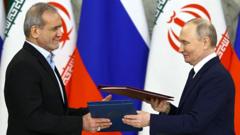The Gaza Humanitarian Foundation claims Hamas intimidated its workers, leading to increased violence and complications in delivering essential supplies.
Chaos in Gaza Aid Distribution Amidst Rising Tensions

Chaos in Gaza Aid Distribution Amidst Rising Tensions
The new aid distribution system in Gaza faces serious challenges as reports surface of threats against aid workers.
The chaotic launch of the Gaza Humanitarian Foundation's aid distribution efforts has raised significant concerns, with reports of threats aimed at workers involved in delivering crucial food supplies. The foundation, which was established to circumvent traditional aid channels, faced allegations from Hamas about its neutrality while the militant group vehemently denied accusations of intimidation. Tragically, violence has escalated around these distribution sites, with nearly 50 deaths and hundreds injured since operations began at the end of May.
The backdrop of this turmoil is Israel’s ongoing conflict with Hamas, which has devastated many areas in Gaza, resulting in the displacement of nearly all of its two million residents at least once. As part of its military strategy, Israel had imposed a blockade limiting the flow of goods, including food and fuel, into the region, which only began to lift in mid-May after an 80-day cessation. Meanwhile, aid organizations, including the United Nations, have expressed serious concerns regarding the new distribution model, arguing that it has been weaponized as part of Israel’s broader military objectives against Hamas.
The Gaza Humanitarian Foundation, which operates with support from private American security firms and the Israeli military, has set up a limited number of distribution points, complicating the situation further as multiple humanitarian groups boycotted involvement. While Israel emphasizes that Hamas had previously diverted aid under the UN's administration, the United Nations has countered that evidence of such behavior lacks substantiation. The tragedies unfolding in the region continue to raise alarms over the dire humanitarian crisis that Gazans are grappling with amidst unrelenting conflict.
The backdrop of this turmoil is Israel’s ongoing conflict with Hamas, which has devastated many areas in Gaza, resulting in the displacement of nearly all of its two million residents at least once. As part of its military strategy, Israel had imposed a blockade limiting the flow of goods, including food and fuel, into the region, which only began to lift in mid-May after an 80-day cessation. Meanwhile, aid organizations, including the United Nations, have expressed serious concerns regarding the new distribution model, arguing that it has been weaponized as part of Israel’s broader military objectives against Hamas.
The Gaza Humanitarian Foundation, which operates with support from private American security firms and the Israeli military, has set up a limited number of distribution points, complicating the situation further as multiple humanitarian groups boycotted involvement. While Israel emphasizes that Hamas had previously diverted aid under the UN's administration, the United Nations has countered that evidence of such behavior lacks substantiation. The tragedies unfolding in the region continue to raise alarms over the dire humanitarian crisis that Gazans are grappling with amidst unrelenting conflict.






















